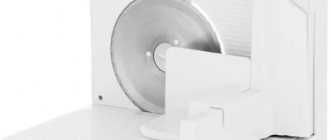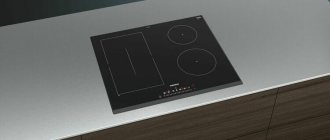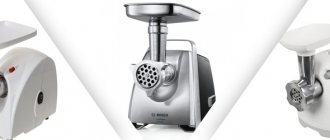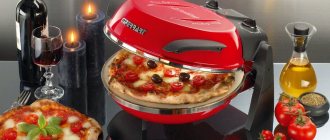Before purchasing a juicer for carrots and beets, the consumer asks questions: which type to choose - centrifugal or auger, which set of functions will be more optimal, which manufacturer to trust.
The functionality, ease of use, and service life of the device will depend on the correct conclusions.
We analyzed reviews from experts and ordinary users and selected the best carrot and beet juicers for you.
When selecting models, we took into account official test results (Rostest), owner reviews about the best juicers in terms of price/quality ratio.
The rating was assigned based on the results of an analysis of all indicators, and also took into account ease of use, reliability, adequacy of price and quality. Our article presents only the leaders of the rating in 2021!
Rating of the TOP 12 best juicers for carrots and beets of 2021
| Place | Name | Price |
| TOP 4 best juicers for carrots and beets in price/quality ratio for 2021 | ||
| 1 | Polaris PEA 1031 | Find out the price |
| 2 | Kitfort KT-1104 | Find out the price |
| 3 | Scarlett SC-JE50S43 | Find out the price |
| 4 | Philips HR1919 Avance Collection | Find out the price |
| TOP 4 best auger juicers for carrots and beets | ||
| 1 | Philips HR1947 Avance Collection | Find out the price |
| 2 | REDMOND RJ-980S | Find out the price |
| 3 | Oursson JM7002 | Find out the price |
| 4 | Mirandi J-100 | Find out the price |
| TOP 4 best inexpensive juicers for carrots and beets | ||
| 1 | Scarlett SC-JE50S30 | Find out the price |
| 2 | Kelli KL-5091 | Find out the price |
| 3 | Scarlett SC-JE50S42 | Find out the price |
| 4 | Scarlett SC-JE50S11 | Find out the price |
What type of juicer is better to choose?
- Centrifugal juicers have high productivity, but when working with soft fruits they discard too wet pulp;
- screw ones have been in increasing demand over the past few years because they work slower compared to centrifugal ones, due to which 95% of the juice from any fruit (including soft fruits) is successfully squeezed out;
- citrus is the most “highly specialized” machine for those who drink citrus juices very often, while others do not particularly like it, because otherwise you should think about purchasing a centrifugal combined model with a special citrus press attachment.
How to choose and which one is needed in the kitchen?
Our analysts have studied the juicer market in 2021 and are ready to share life hacks that will help you choose a reliable and durable kitchen appliance.
- Device type . To obtain juice from solid vegetables, two main types are used - manual and electric. The best option is electric juicers.
- Shredder type . It can be rotary or auger. The first option is more affordable, the second is functional and effective. It’s good if the choice was made in favor of a screw juicer.
- Power . For home use, a power of 400-800 W (with a centrifuge), about 1000 W (for an auger) is sufficient.
- Capacity volume . The model is equipped with one or two tanks for fresh juice and cake. For one person, 200 ml is enough, and for three - from 1 liter.
- Additional features . The level of comfort when working with the device depends on the number of parts. It’s good if the model has a spout on the body, automatic feed of raw materials, a tray lid, and protection systems.
Varieties
The modern market offers many juicers, which are divided into types:
- manual;
- mechanical;
- electric.
Manual devices are not intended for extracting juice from carrots. A mechanical carrot juicer looks very much like a meat grinder and is driven by physical force. Such models have one significant drawback: squeezing juice from hard fruits and vegetables is quite difficult, since you will have to put a lot of effort into obtaining the drink. But for every minus there is a plus: juice squeezed in this way will be much healthier, since it will not be subject to heat from the electric mechanism.
Electric juicers are quite easy to use and are divided into:
- citrus;
- berry;
- vegetable;
- universal.
The last two options are perfect for obtaining carrot juice, since such models are equipped with a large number of attachments.
By type, carrot juicers are divided into:
- screw, working on the principle of a meat grinder;
- centrifugal, operating at high speeds, at which centrifugal force separates pure juice and pulp.
The screw units operate quietly, at minimum speed, the cake comes out dry, the drink itself is homogeneous, retaining the maximum of useful substances. But this model is not suitable for processing large quantities of root crops due to the high time costs. Centrifugal juicers, on the contrary, are characterized by super-fast operation; they are optimal for obtaining juice from huge volumes of raw materials. The wide inlet allows you to load carrots without preliminary chopping; the drink turns out clean with a minimum amount of pulp. One of the disadvantages of the device is the interaction of juice with air during the cooking process, which is why the finished product turns out with foam and is quickly divided into fractions.
Auger
Centrifugal
Which company should you choose?
Devices from Russian manufacturers Rossoshanka, Salyut, Neptune, Dachnitsa are distinguished by high performance and build quality . But the devices cannot be called quiet. The noise level during operation exceeds 70 dB.
Juicers from Philips, Scarlett, Kitfort are more functional devices with a wide range of capabilities and the necessary equipment.
Such juicers operate much more quietly, but their cost can be prohibitively high. Which manufacturer to choose depends on the individual preferences of the buyer and financial capabilities.
Types of juicers for hard fruits
There are several types of mechanisms for hard vegetables. They are divided into manual and electric.
Manual juicers
A mechanical juicing machine is a bit like an old cast iron meat grinder, but its operating principle is more complex. It has a similar massive frame with a handle at the end. The main working mechanism is the shaft, which, unlike the analogue of the meat grinder, has the shape of a cone, tapering towards the end. A perforated metal “bag” is put on the improvised drill. The squeezed juice will flow through the holes in its body. The narrow part of the cap has a fairly wide opening. Its task is to release waste material (cake) out.
A mechanical juicer is similar to a meat grinder
This mechanism is the cheapest and usually lasts for several decades. However, a manual juicer will upset the lazy owner. To get at least 200 grams of ready-made carrot juice, you will have to apply real physical strength and twist about 1.5 kg of peeled carrots.
But harsh technology also has its obvious advantages. When pressed manually, the metal does not heat up and does not oxidize the finished product, preserving the maximum amount of useful elements.
An interesting advantage of manual juicers is the high humidity of the pulp. On the one hand, this reduces the amount of pure juice. But for experienced housewives this means the availability of useful raw materials for culinary experiments. The cake can be used for fresh salads, various rolls, where the function of rice is performed by finely grated carrots, as well as for baking.
Centrifugal juicers
Popular inexpensive units based on the principle of grating and pushing the juice of vegetables and fruits through small holes with a separate outlet for waste disposal. The filter with a disk on which the knives are located is located inside a wide-necked bowl. You can load whole carrots into the container, and the motor located at the base of the base unit will grind the fibers at a speed of 10 to 40 thousand revolutions per minute.
Like all electric kitchen gadgets, a centrifuge juicer requires minimal effort from its owner. Its function will be to add the finished product, turn on one of the start modes and place containers for the finished juice.
The advantages of such a device include:
- relatively affordable cost;
- speed of work;
- Convenient feeding of root vegetables through a wide throat.
The disadvantages include:
- high noise level (usually more than 50 dB);
- average spin quality;
- contact with metal, due to which the shelf life of the juice will be no more than an hour, and will also lead to a partial loss of beneficial microelements.
Auger juicers
Essentially, this is an automated version of a manual juicer, since the auger is an improved analogue of a metal spiral shaft. However, in addition to the spiral squeezing process, auger juicers have special attachments with ribs that also increase the compression force. Therefore, it is precisely such devices that will give the maximum amount of juice. There are models with two screws, which are located parallel and rotate in opposite directions. This principle is found in expensive devices and provides practical dry pulp.
The advantages of screw models include:
- low noise level;
- gentle spin without oxidation;
- the ability to store juice for about 2 days in a closed container;
- a thicker consistency (a bit like a smoothie), which retains healthy fiber in the drink;
- the maximum possible amount of juice that can be obtained from carrots.
Among the disadvantages, the first mentioned are the high cost, often narrow necks for serving (they will require preliminary cutting of large carrots into slices) and a lower feeding speed of the finished product.
Manual or electric
Home appliance stores offer a wide range of different juicers, but there is no specific device for squeezing juice from carrots. There are those models that are designed for processing any vegetables and fruits, including hard ones - carrots, beets, etc. First of all, all devices are divided into manual and electric.
Manual juicers are similar in appearance and operating principle to manual meat grinders; they are attached to a surface, after which the fruits are loaded inside, and the user turns the handle to squeeze out the vegetables and fruits. There are adherents of manual juicers who believe that this way the juice remains unchanged, since it does not heat up from electric current and does not oxidize upon contact with air. However, such devices are only suitable for soft vegetables and fruits, since in the case of carrots it will take a lot of effort to complete the process.
In this regard, electrical devices are preferable, since the user’s participation in the preparation of a freshly squeezed drink ends with pressing a button to turn on the device. Electric juicers are divided, in turn, into citrus and universal. The first variety is intended exclusively for making juice from lemons, oranges, tangerines, grapefruits, etc., since it has low power and a single conical attachment that cannot crush other fruits. Universal units are designed for processing any vegetables, fruits and berries, so when choosing, you need to focus on them.
What power should I choose?
Power is a fundamentally important indicator, primarily for centrifugal juicers, since the rotation speed of the centrifuge, and therefore the quality of juice extraction, directly depends on it.
All equipment of this type can be divided into models up to 500 W, 500-1000 W and more than 1 kW. Moreover, the higher the power indicator, the greater the productivity of the equipment and the dryness of the discarded cake.
For auger equipment, due to their technological features, the sufficient power for operation is 100-300 W, and for citrus fruits - from 25 W, since they “give off” juice very easily.










